You didn't think I was going to skip the other half of the Côte d'Or having done a lengthy post on the Côtes de Nuits did you? No, no, no. That post generated over 200 views and one - yes ONE - comment, which is actually a lot more than many get. I view this as valedictory I'm afraid, Seth this is all your fault. There will of course be birdy content too, so make you read the whole thing so you don't miss it!
So, to the southern sector. Whereas the Côte de Nuits is famed for its red wines rather than its whites, in the Côte de Beaune it is the other way around - the whites dominate. For the most part that is, there are also some significant red wine appellations, not least Beaune itself, but overall it is the great Chardonnay vineyards that people equate with the area. Puligny and Chassagne share the great mineral rectangle of Montrachet, and the village of Meursault although without any Grand Crus produces superlative creamy white wines that can be divine. The same obscene price increases are in existence here, and with over two decades of work under my belt it is a source of great sadness that wine I could afford in my twenties on a relatively meagre salary is now completely out of my reach and what is more is getting further away. As with the top wines from further north, who actually drinks this stuff?!
The Côte de Beaune actually starts a little north of the town of Beaune at the village of Ladoix-Serrigny, although the wine here is typically labelled simply as Ladoix. I have never knowingly had a bottle, have none in my cellar, and know nothing at all about it. I suspect that the wine, like the village itself, is simply overshadowed by the hill of Corton. In theory given that some of the production comes from the slopes of that hill but without the cachet of the label there should be some good value wines here. Something to look at perhaps, but unfortunately I missed my opportunity and drove straight through to Aloxe-Corton....
This is a source of top notch red and white, the Grand Cru of Corton (for red) and Corton-Charlemagne (for white). As you will probably realise by now this is not a happy hunting ground for me these days, but I do have a couple of bottles for white from 2009 which I am hanging on to. These were in fact a replacement for some completely oxidised wines from a prior vintage which the Domaine ended up recalling en masse and re-issuing. Mrs L and I drank the first bottle for our 19th wedding anniversary last year and it was stellar - the sommelier at the restaurant we took it to declared it to be "lively", which I think was a nice way of saying we we were drinking it too early.
A short word on premature-oxidisation, that scourge of wine which turns what should be delightfully light and floral whites into turgid dark yellow cesspits that taste like bad sherry. The interaction of oxygen and wine is an important part of development, and is expected over time. Premature oxidisation, or premox, is what happens when this reaction happens much more quickly than has been intended. Poor quality corks that are far too porous are to blame, and it was not unusual back in the day to have over half of any given case to be a write off, especially white wines for some reason though it affected both. I remember taking a bottle of Puligny-Montrachet Les Pucelles from Domaine Leflaive to a significant birthday meal and it being nigh on undrinkable - and this is a wine that costs around £400 a bottle (now, not then....)! I had a case of three and all three were poxed, just outrageous. And of course there is no recourse for the wine drinker, or at least very rarely - it was exceptional that Bonneau du Martray replaced the whole lot when you think about it. Of course this could be avoided if one drank the wine young, but these were wines that should have matured and evolved for decades. Although it still happens thankfully it is now much rarer. There is now much more use of sulphur which stifles the interaction of wine and oxygen (but not entirely, as that would be no good) but more importantly many producers have moved away from natural cork, a variable material, to DIAM, which is not. Hell will freeze over before the Burgundians start to use screw caps I expect, but when I buy white wine these days I am much more likely to buy something expensive (high correlation with long-lasting) if it has a DIAM closure. Anyway, that bottle of 2009 was wonderful, and I am crossing my fingers that the other two also have good quality corks that are doing their job properly.
 |
| The Hill of Corton |
The Hill of Corton, neatly topped on the plateau with a small wood, is a landmark that can be seen from miles around. Although I can't really afford the wine the slopes produce, to the west is the much more reasonable village of Pernand-Vergelesses. These side appellations, and there are more further south, are currently the best/only places to go shopping. The quality is equal in many cases, but it is what is on the label is all important for wine collectors, and so these wines seem to mostly slip under the radar. The word will spread of course - more and more people will get pushed out of the mega appellations and look for value elsewhere, just as I have. Inevitably that means prices will rise here too, and which point I don't know what will happen. What wine-lovers need is a huge and long-lasting recession in the Far East that will slash demand.
Moving south you come to Savigny and Chorey, both of whom use "les-Beaunes" for marketing their wine, hence Savigny-les-Beaune and Chorey-les-Beaune. These are in my mind primarily villages from which to get decent pinot noir at a less elevated price than Beaune itself, and a number of producers are well worth following. If you like wine that is, maybe you don't. If you don't you are of course missing out, but equally you are one less person in the ring for a bottle. Yes, maybe don't read any further, it's fine, I don't need page views.
 |
| The inner courtyard of the Hospices de Beaune |
Beaune is next up, the administrative centre and hub of the whole of the Côte d'Or. It is a lovely town in its own right, and even if you did not like wine you could happily spend a day walking around its cobbled streets and visiting local landmarks, the most notable of which is the Hospices de Beaune, a hospital for the poor set up in 1443, predating the NHS by 500 years. It still functions as that today, although the medical side is now elsewhere in Beaune and the original buildings of the Hotel-Dieu are now a museum. The architecture is stunning, inside and out, and it has been immaculately preserved, thanks in no small part to wine. Like many venerable institutions the Hospices de Beaune owns huge... tracts of land, which in this part of the world means huge revenue. These revenues are crystallised once a year by means of a famous charity wine auction that attracts the whole world, keen for a slice of the action. The Hospices both makes and bottles its own wine, and local vignerons also contribute by either given them a barrel, or by vinifying some of the Hospice's holdings.
 |
| Just a regular ward |
 |
| Chanson's cellar in the Beaune bastion |
These and all the other Beaune vineyards are mostly to the west of the town. Although some white wine is made I associate Beaune squarely with reds, and there are a plethora of great lieu dits that start to cause mild salivation. Les Grèves, Les Fèves, Les Marconnets, Clos des Mouches - I could go on. There is no single way to describe Beaune - you can find masculine wines that are burly and long-lived; you can have seductive lighter styles if that is what you are after. The only thing to do is to taste as many as possible to see what you like. I based my trip in Beaune....
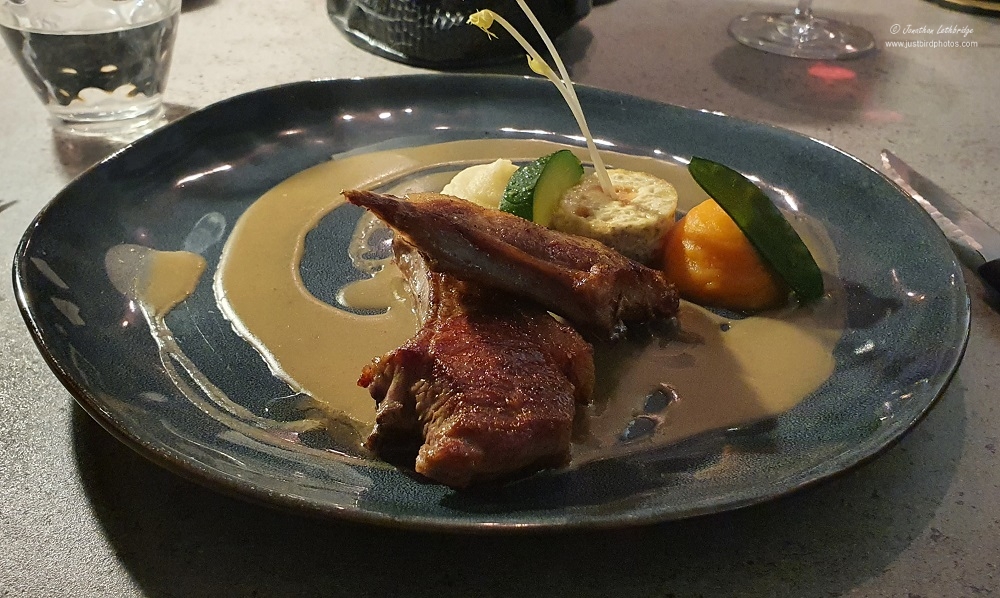 |
| Gluttony at La Ciboulette |
I had three nights there as well as a free morning, and I spent all this time eating and drinking, as all visitors to the town should. I visited the big negotiant Chanson Père et Fils, and was taken on a tour of their cellars in the town walls followed by a tasting session. I also went to a fantastic wine shop called Mon Millésime, and ate at several establishments that served wine by the glass so that I could extend the breadth of my experience. Burgundian food is solid stuff - no light salads here or delectable platters of seafood. This is a diet based on red meat, rich creamy sauces, and cheese. Oh the cheese! To die for, which if I lived there I probably would have done by now.
This was partly the reason for taking Mrs L's fold-up bike with me in the back of the car. Also in my thoughts were the ability to enjoy wine with lunch on at least one day, and to get a far better appreciation of the literal lie of the land. There is a well marked cycle path that runs south from a park on the west side of Beaune and goes through all the major villages and their vines, so what better way to get to lunch in Puligny?
*** WARNING: BIRD CONTENT COMING UP ***
I recorded 16 species in the Parc de la Bouzaise before pedalling south, including Nuthatch , Siskin, and Short-toed Treecreeper.
*** BIRD CONTENT FINISHED ***
It is a short cycle to Pommard, a lovely little village. The wines here have a reputation for being rustic and powerful, although as ever you need to go with individual producers. I much prefer Volnay, the next village along. Here the wines are known for their silken elegance, and if you find a bottle from a good producer that expresses the typicity of the appellation then I guarantee you will not look back. Sorry, what I meant to say is that it is all totally disgusting and if I were you I would avoid it completely. Also don't bother buying wine from Monthelie or Auxey-Duresses, villages slightly to the west of the main côte before you get to Meursault. They represent incredibly poor value and should not be touched with a bargepole. Clear?
In the centre of Volnay, just underneath the small village, the cycle path heads east across the main road next to the Clos de Verseuil, a monopole vineyard belonging to Clerget, and after Carelle Sous la Chapelle heads south towards Meursault. Volnay and Pommard produce only red wine, but Meursault is dominated by white. And what a white it is! The best examples in my view are the ones which have a creamy butteriness that is simply not found anywhere else, brilliant with food. At lunch later on I tried a Meursault made by a producer based in Puligny, and it had none of this, it was simply taut and mineral. It wasn't that it was bad, far from it and I love that style of wine, but I just found it pointless. This is why learning about individual producers and tasting wine is so important - from that point on I resolved not to buy Meursault from here. Puligny, Saint-Aubin and Chassagne yes, Meursault no. One of my most memorable experiences in my formative wine appreciation days is from here. With our Guide Hachette in hand Mrs L & I knocked on a random producer's door in Meursault, which typically is also the family home. The vigneron I think had been eating lunch, yet happily led us to his cellar, reached down some steps in his garage, and which stretched under the main road, a long, dark and cool space. Here we tasted a range of the last year's production and were totally captivated. Wine has never really tasted the same since, but very occasionally a bottle opened here in Wanstead can transport me back to that cellar. We left with several bottle at 200 francs each (my memory is a little hazy but I think this trip was in the late nineties - good luck getting a bottle of Meursault for that today!), and were sent to see his mates at the next village along. They were a raucous post-prandial bunch, insisting they were peasants barely scraping a living, and clearly deeply amused by two fresh-faced english twenty-somethings mangling french and trying to cadge some free wine. We had a great visit! For the life of me I cannot remember the names of either of these two places, and it is only in writing this that I now wish that I had deviated from the cycle route to try and find them. I have a clear memory or a regular white house with the garage off to the right next to the road. I've scanned satellite images and can't find it, and trawling through the names of vignerons has drawn a blank. A shame. I would have liked to have gone back to see if was the same.
It was a longer cycle to Puligny-Montrachet, and I had stopped so frequently for rests and to take photos that I only just made it to my lunch booked at Domaine Olivier Leflaive in time. This is a big domaine with fingers in multiple pies, including a hotel and restaurant in the village. Their range of wine is so vast I can actually afford to drink at the lesser end of their scale, and it is very good indeed - their "Les Sétilles" is essentially our house white, and comes from various parcels around Puligny and Meursault. The sommelier solemnly wheeled my bike into an inner courtyard as I had left the key to the lock in Beaune, and I sat down to a fantastic tasting lunch. Puligny and neighbouring Chassagne are very much white wine villages, so the tasting flight was mostly chardonnay and thankfully the food was on the lighter side to match. Apart from the obligatory cheese course, naturally, but white wine does in fact go very well with creamy cheeses.
After lunch I rolled straight onto a vineyard tour where we walked a little west towards the slope of the hill. If you have been paying attention this is one of those places where vineyards that are the greatest of the great sit right next door to lowly village wines. We were led to one of these hallowed crossroads. Behind me were the 'normal' vineyards. To my right was the top 1er Cru Les Pucelles, origin of my horribly tainted wines from many years ago. To my left the Grand Cru of Bienvenue-Bâtard-Montrachet. Directly above that is Montrachet itself, and above that Chevalier-Montrachet. It was being ploughed with a tractor and I joked they should be using a horse but nobody got it. Along with Meursault, Puligny-Montrachet is my favourite white, and were money no object I would head here every time. As it is, Saint-Aubin, slightly to the west, is a favoured village. Sorry, what I meant to say was that wines from Saint-Aubin are vile and undrinkable and that you should not under any circumstances seek them out.
 |
| Another prestigious address that I rarely get to sample |
Back at the domaine the other tour participants headed off for a tasting, and I headed to the local wine shop/bar. Here I fell in with some locals who had dropped in for a glass of wine after work, and ended up spending the rest of the day here talking about the folly of Brexit, COVID, food, and absorbing the frequent anti-English jovial ribbing that english people who speak french are always subjected to. It was a fun couple of hours. By now it was dark and my new friends could not believe I was about to cycle back to Beaune, so one of them, Benoit, offered to drive me back in his Range Rover. Mais bien sûr! He was a vineyard broker, big business in Burgundy, and despite the fact he was likely several sheets to the wind I accepted happily. I don't condone it obviously, and would not do so myself, but.....nice big car, quiet roads, and frankly Benoit had probably done this more than once. Perhaps every night in fact, and of course we made it without any problem at all and I made my dinner appointment right on time after having put my bike back in the car along with my newly acquired stash of wine.
 |
| You might be bored but you can't say it isn't pretty |
This of course meant I never made it to Chassagne-Montrachet or Santenay, the next and final villages that make up the Côte de Beaune. I like Chassagne a lot, it does not quite have the purity of Puligny, but it tends to be a little cheaper and if you can find a decent producer you can find simply lovely wines that are lean and mean but with a slightly more colourful character than those from the neighbouring village. Less steel, more soul perhaps? By the way, there is a wonderful book about the area simply called "Puligny-Montrachet" by Simon Loftus, more about the people than the wine and a highly enjoyable window into France.
Burgundy continues south into the Côte Chalonnaise, but the Côte d'Or and my trip both finish here. Oh yes, I forgot to say, where the stream cuts through Meursault, just before the big hill south out of the village, I found a Brambling in with House Sparrows. Apologies if this is a little off-topic.



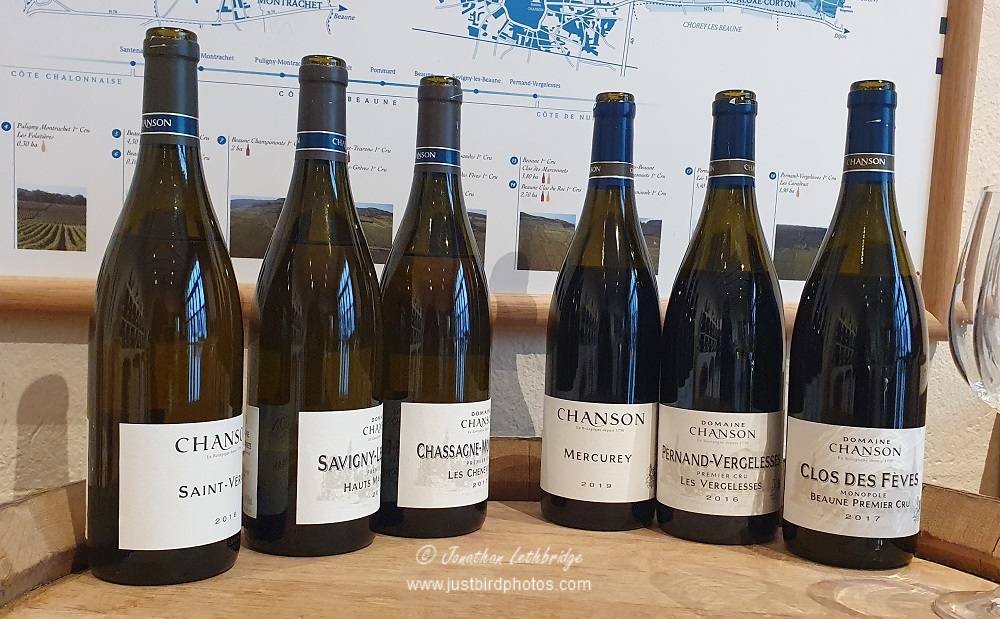

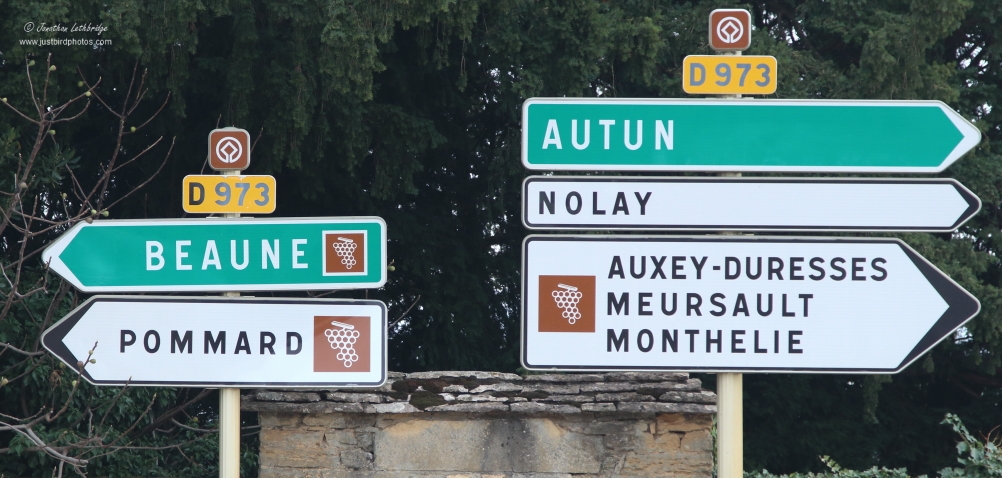
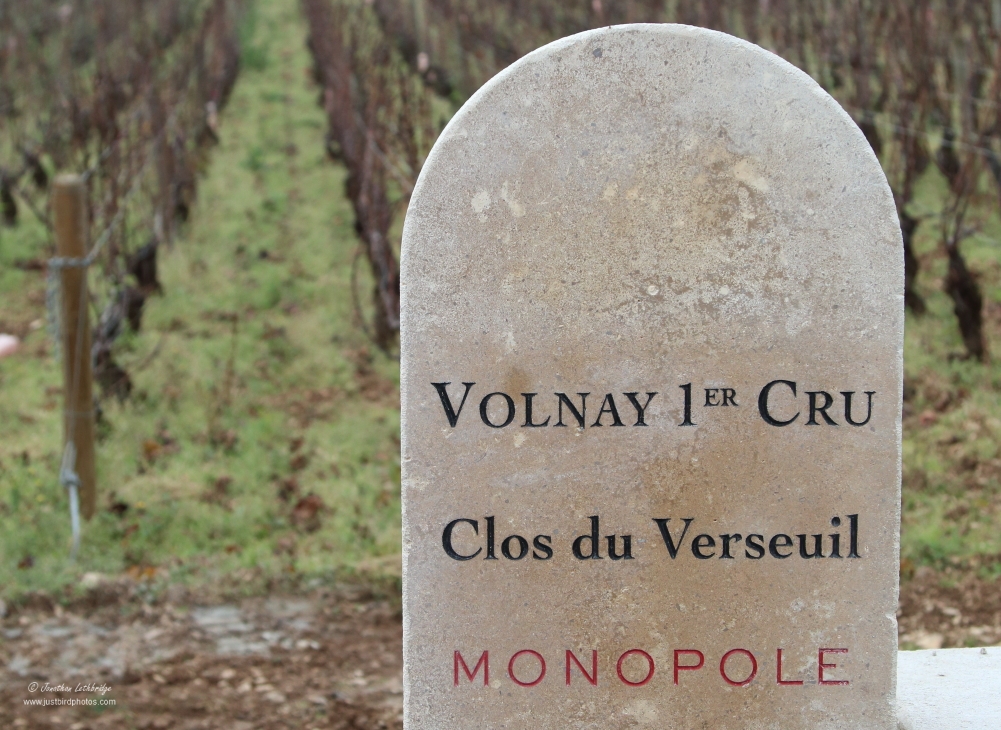



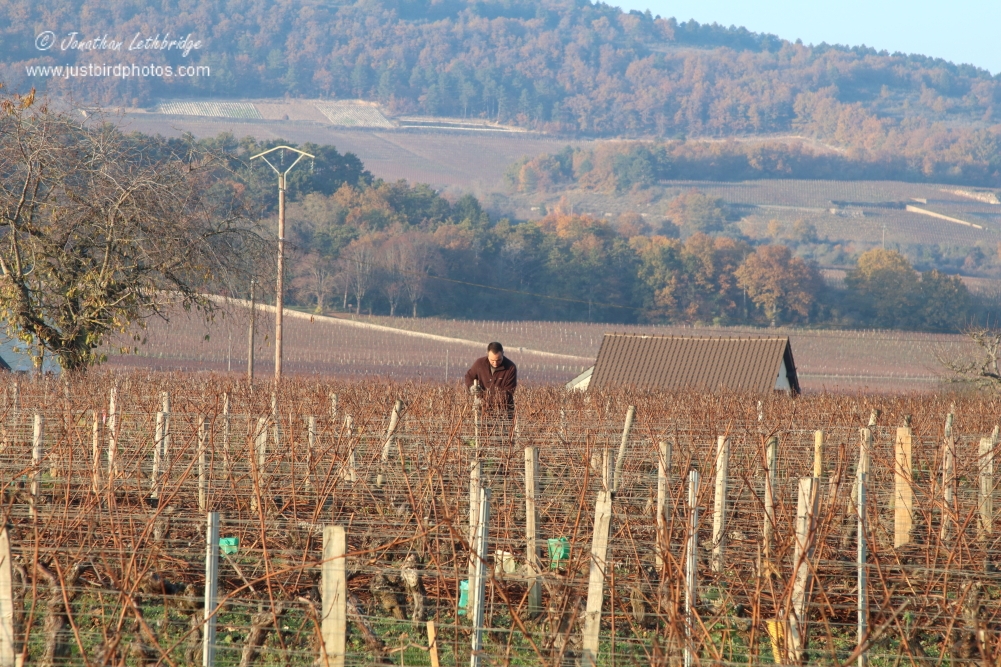


I'm not taking any responsibility whatsoever for your writing of this marvellous piece. You should seek a career writing for one of those posh luxury mags, y'know the ones with hounds, johdpurs, yachts and antique vases in them (clearly I have no idea of luxury mag content. Dipterists Digest is more my kinda thing...) I do think you overdid it with the birdy bit, talk about ramming it down your neck, but all in all another highly enjoyable read. Hope you scrape up a second comment this time.
ReplyDeleteYes I am sorry about that. I got to the end and realised I had unconscionably not mentioned the Brambling. I think I know the magazines you are talking about, you see them on coffee tables in airport lounges and so on. Don't think I have ever read one, but at least one small facet of my life appears to measure up - a very ugly tall brown fridge thing in the kitchen that stores about 200 bottles.
DeleteSecond comment! Fantastic trip and writing, shouldn't be read for free! I can remember when red Burgundy often had a splash of Algerian red in it to rescue it. Once bought a bottle of 1972 Romanee Conti for £2! Can't drink the whites anymore unfortunately, the acidity kills me; hope you avoid this as your evident delight in the wine and region shines through in your writing. Á votre santé.
ReplyDeleteMerci. It does seem divisive as a wine region, I think particularly as you can pay so much money for a really average bottle - there is a lot of hit and miss for sure. As for your £2....... jesus.
DeleteHi Jono, while I totally agree with you about the greater reliability of DIAM stoppers for wine bottles, I'm very torn over the issue. There's a lot of wonderful wildlife habitat in Spain and Portugal that would cease to have an economic function, and hence be under extreme pressure for a change of land use, if winemakers no longer used real corks. I think on balance I'll put up with the occasional duff bottle if it keeps the cork oak forests intact - but then, I don't spend so much on my bottles of wine as you do! Cheers, John
ReplyDeleteCheers John! I confess I had not thought of that, only at my chagrin as I poured such promising wine down the sink. But it is a good point. Many producers continue to use natural cork, but the analysis process is now top notch, and whole batches are screened for porosity issues as well as any hint of TCA (something which can totally neuter red wine) before going anywhere near bottles.
DeleteImpressed with the bike Jono: #lowcarbonconnoisseuring?
ReplyDeleteA spring or summer trip to the region by bike only would be amazing - north to south. Various companies will organise this for vast fees, but I always prefer the DIY approach.
Delete